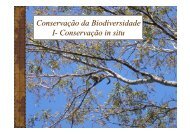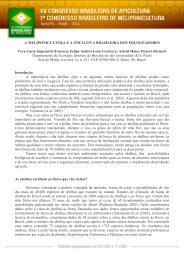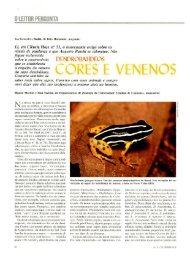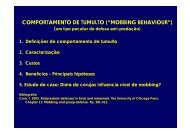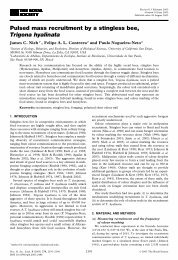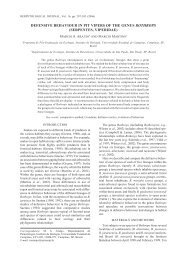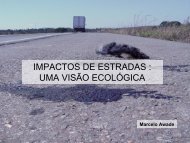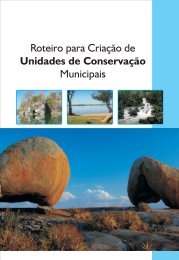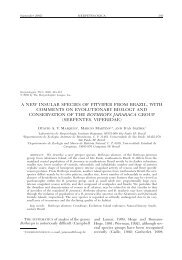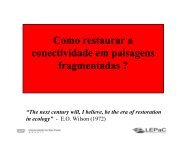(Testudines, Chelidae) IN SE BRAZIL - Ecologia - USP
(Testudines, Chelidae) IN SE BRAZIL - Ecologia - USP
(Testudines, Chelidae) IN SE BRAZIL - Ecologia - USP
Create successful ePaper yourself
Turn your PDF publications into a flip-book with our unique Google optimized e-Paper software.
Bol. A soc. Herpetol. Esp. (2000) 11 (2)<br />
A NEW RECORD AND OB<strong>SE</strong>RVATIONS<br />
OF VANDERHAEGE'S TOAD-HEADED TURTLE,<br />
Phrynops vanderhaegei (<strong>Testudines</strong>, <strong>Chelidae</strong>) <strong>IN</strong> <strong>SE</strong> <strong>BRAZIL</strong><br />
FRANCO LEANDRO SOUZA 1 *, MARCIO MART<strong>IN</strong>S 2 & RICARDO JAN<strong>IN</strong>I SAWAYA 3<br />
1<br />
Universidade Estadual de Campinas, Institute de Biologia, Departamento de Parasitologia.<br />
CP 6109. 13083-970, Campinas, SP. Brasil. e-mail: flsouza@unicamp.br<br />
2<br />
Universidade de Sao Paulo, Institute de Biociencias, Departamento de <strong>Ecologia</strong>.<br />
CP 11461. 05422-970, Sao Paulo, SP. Brasil. e-mail: jararaca@ib.usp.br<br />
3<br />
Universidade Estadual de Campinas, Institute de Biologia, Departamento de Zoologia.<br />
CP 6109. 13083-970, Campinas, SP. Brasil. e-mail: sawaya@unicamp.br<br />
• corresponding author<br />
Resumen: Se presenta una nueva localidad de Ia tortuga Phrynops vanderhaegei en Brasil<br />
sudoriental. Los especimenes se localizaron en un area de savana (cerrado) con pequefios tramos<br />
de bosque ripario. Se cementa brevemente el habitat circundante. El hallazgo de esta poblaci6n<br />
aislada puede ser importante en Ia conservaci6n de Ia especie ya que indica que otras poblaciones<br />
podrian sobrevivir y reproducirse en pequefios fragmentos con vegetaci6n bien conservada.<br />
Key words: Brazil, <strong>Chelidae</strong>, conservation, Phrynops vanderhaegei, turtle.<br />
Records related to geographical distribution<br />
for Brazilian freshwater turtles are relatively rare<br />
and the lack of such basic information has<br />
caused mistaken interpretations about species<br />
range (V/\NZOL<strong>IN</strong>I, 1994 ). Since ecosystems are<br />
becoming highly fragmented mainly due to<br />
human action, all information available should<br />
be used to identify areas that harbor threatened<br />
species, which would allow the development of<br />
appropriate management programs. In this note,<br />
we report a new locality record for the<br />
Vanderhaege's toad-headed turtle, Phrynops<br />
vanderhaegei, and provide comments on its<br />
conservation and habitat in southeastern Brazil.<br />
Phrynops vanderhaegei is a medium-sized<br />
freshwater turtle, with carapace length around<br />
250 mm (ERNST & BARBOUR, 1984; CABRERA,<br />
1998). Few records concerning its natural<br />
history are available. Among these, anedoctal<br />
information indicates that this turtle is<br />
carnivorous and diurnal (ERNST & BARBOUR ,<br />
1989; CABRERA, 1998). Shallow water lagoons<br />
with dense aquatic vegetation and occasional<br />
scattered trees in the margins characterize its<br />
habitat (ERNST & BARBOUR, 1989; CABRERA,<br />
1998). The distribution of P. vanderhaegeiis still<br />
poorly known (Figure 1 ). with its southern limit at<br />
Mala Frigo (Santa Fe, Argentina) and the<br />
northern limit at Cuiaba (Mato Grosso, Brazil;<br />
IVERSON, 1992; CABRERA, 1998).<br />
For the state of Sao Paulo (Brazil), the only<br />
record for P. vanderhaegei is from a place<br />
around the cities of Perus and Caieiras<br />
Figure 1. Map showing locality records of Phrynops<br />
vanderhaegei (modified from IVERSO"', 1992). Star denotes<br />
the new record, ltirapina. Sao Paulo state, southeastern<br />
Ora7il Argentina 1 - Mala Frigo; Paraguay: 2- Asunci6n, 3<br />
- Tobali, 4 - Nueva Germania, 5 - Capitan Brado, 6 - C.<br />
Cur6; Brazil: 7 Cuiaba, 8 - Perus/Caieiras, 9 - ltirapina.<br />
85
Bol. Asoc. Herpetol. Esp. (2000) 11 (2)<br />
Figure 2. A JUvenile female of the Vanderhaege's toad-headed turtle, Phrynops vanderhaege1, captured at ltirapina, Silo<br />
Paulo state, southeastern Brazil Photo: R. J. Sawaya.<br />
(IVERSON, 1992; IVERSON, pers. comm.), which<br />
is the easternmost known limit of its distribution<br />
(Figure 2). We found the Vanderhaege's toadheaded<br />
turtle at"Esta9ao Ecol6gica de ltirapina"<br />
(ltirapina Ecological Station; hereafter ltirapina),<br />
which is located within the municipalities of<br />
ltirapina and Brotas (22°15' S, 47°49' W), Sao<br />
Paulo state, southeastern Brazil (Figure 1 ). This<br />
locality is about 180 km west of the<br />
Perus/Caieiras record . The ltirapina reseNe is a<br />
2300 ha tract of savannas (cerrado), from<br />
grasslands to dense arboreal formations, with<br />
small stretches of riparian forests (GIANOTTI,<br />
1988; pers. obs.).<br />
Three individuals of P. vanderhaegei (Figure<br />
1) were captured in pitfall traps with drift fence<br />
(CECH<strong>IN</strong> & MART<strong>IN</strong>S, 2000), which are being<br />
used to suNey the vertebrate fauna of ltirapina.<br />
Two were hatchlings (
Bol. Asoc. Herpetol. Esp. (2000) 11 (2)<br />
commercial Pinus and Eucalyptus forests cover<br />
most of the area (GIANOTTI, 1988; pers. obs.).<br />
In contrast with ltirapina and Cuiaba (Mato<br />
Grosso, Brazil), where the typical vegetation is<br />
composed of several savanna formations, the<br />
region of the Perus/Caieiras locality is covered<br />
by Atlantic rainforest (sensu lato). The Lobo<br />
stream belongs to the mid-Parana river basin<br />
and the main river from Perus/Caieiras region,<br />
the Tiete river, is also a tributary of the Parana<br />
river. The Tiete river runs through a wide area of<br />
the central region of Sao Paulo state, with its<br />
origin located in the west side of the Serra do<br />
Mar mountain complex (Figure 2). On the other<br />
hand, rivers where P. vandehaegei were<br />
recorded in Cuiaba (Brazil), Paraguayan, and<br />
Argentinean localities belong to the Paraguay<br />
river basin. Hundreds of years ago, the<br />
vegetation along these river systems was<br />
continuous and both the coastal Atlantic<br />
rainforests and the upland mesophytic forests<br />
extended their domains to wide areas.<br />
However, due to human action beggining<br />
around the XVII century, these forests were<br />
drastically reduced (DEAN, 1996). Thus, species<br />
which once could make migrations throughout<br />
these vegetation corridors, became isolated in<br />
disjunct populations. The dependence of such<br />
corridors for migration is recorded for some<br />
groups, including reptiles, birds, and mammals<br />
(VANZOL<strong>IN</strong>I, 1976; REDFORD & FON<strong>SE</strong>CA, 1986;<br />
GUIX, 1997; VIVO, 1997). If the record of P.<br />
vanderhaegei for Perus/Caieiras region is<br />
correct, then probably the species could be once<br />
spread throughout Sao Paulo state, reaching<br />
also Mato Grosso. Turtles could have used<br />
rivers surrounded by riparian forests, even small<br />
ones like those of ltirapina.<br />
Turtle species richness is high in Brazil<br />
(PRITCHARD & TREBBAU, 1984; IVERSON, 1992)<br />
and several species are often included in<br />
conservation programs (IUCN/SSC, 1991;<br />
IBGE, 1995; <strong>SE</strong>MA, 1998). Since species often<br />
exhibit specific habitat requirements, such as<br />
unpolluted streams and places with dense<br />
aquatic vegetation (PRITCHARD & TREBBAU,<br />
1984; ERNST & BARBOUR, 1989; CABRERA,<br />
1998), they are highly vulnerable to becoming<br />
restricted to isolated populations. This is an<br />
important concern because many turtles species<br />
inhabiting areas threatened by human action are<br />
disappearing (ROCHA-E-SILVA & KISCHLAT,<br />
1992), The cerrado vegetation covers about one<br />
fou rth of Brazilian territory (ca. 2 million km 2 ;<br />
Eiten, 1972, 1992; IBGE, 1993; RATTER el at ,<br />
1997), but due to human action, mainly<br />
agricultural practices and charcoal production,<br />
the cerrado has experienced severe reductions<br />
in its area in the last decades. Presently, only<br />
1.5% of this biome is preserved as Federal<br />
Reserves (IBGE, 1993; RATTER et at , 1997).<br />
The finding of juvenile and hatchlings of P.<br />
vanderhaegeiliving in small savanna fragments<br />
like those of ltirapina, indicates that even small<br />
reserves can be important to the conservation of<br />
this species, with some populations surviving<br />
and reproducing in small patches.<br />
Acknowledgments: The authors are grateful to<br />
F. B. Molina for early identification of the turtles.<br />
J. Iverson kindly permitted the use of the<br />
distribution map and provided locality records.<br />
The lnstituto Florestal and D. Zancheta for<br />
logistical support; and L. Anjos, V. Bonato, and<br />
C.A. Brasileiro for field assistance. Th is is the<br />
paper number 2 of the project "Ecology of the<br />
Cerrados of ltirapina". Fieldwork was partially<br />
supported by a grant from FAPESP (95/09642-<br />
5) and additional funds from Universidade de<br />
Sao Paulo.<br />
REFERENCES<br />
CABRERA, M. (1998): Las Tortugas Continentales de<br />
Sudamerica Austral. BR Capias, C6rdoba, Rep.<br />
Argentina.<br />
CECH<strong>IN</strong>, S. Z. & MART<strong>IN</strong>S, M. (2000): Eficiencia de<br />
annadilhas de queda (pitfall traps) em amostragens de<br />
anfibios e repteis no Brasil. Revta. brasil. Zoo/., 17: 729-<br />
740.<br />
DEAN, W. (1996): A Ferro e Fogo: a Hist6ria e a<br />
Devastar;ao da Mala Atlantica Brasileira. Cia. das<br />
Letras. Sao Paulo, SP.<br />
EITEN, G. (1972): The cerrado vegetation of Brazil. Bot.<br />
Rev., 38:201 -341.<br />
EITEN, G. (1992): Natural brazilian vegetation types and<br />
their causes. An. Acad. brasil. Ci., 64 (Sup I. 1 ): 35-65.<br />
ERnst, C. H. & BARBOUR, R. W. (1989): Turtles of/he World.<br />
Smithsonian Institution Press, Washington, D.C.<br />
GIANOITI, E. (1988): Composir;ao florisfica e estrutura<br />
fitossocio/6gica da vegetar;ao de cerrado e mata ciliarda<br />
Estar;ao Experimental de 1/irapina (SP). Ms. Thesis.<br />
Universidade Estadual de Campinas. Campinas. SP.<br />
A 7
Bol. Asoc. Herpetol. Esp. (2000) 11 (2)<br />
GUix, J. C. (1 997): Exclus~o geogratica e ecol6gica de<br />
Penelope obscura, Penelope superciliaris e Pipile<br />
jacutinga (Galliformes, Cracidae) no estado de S~o<br />
Paulo. Ararajuba, 5: 195-202.<br />
IBGE. (1993): Mapa de Vegetac;ao do Brasil. lnstituto<br />
Brasileiro de Geografia e Estatistica, Rio de Janeiro, RJ .<br />
IBGE. (1995): Mapa da Fauna Brasileira Ameac;ada de<br />
Exterminio. lnsl1tulo Brasileiro de Geografia e Estatlstica,<br />
Rio de Janeiro, RJ.<br />
IUCN/SSC. (1 991 ): Tortoises and Freshwater Turtles. Na<br />
Action Plan for their ConseNation. Compiled by David<br />
Stubbs. Cambridge, U.K.<br />
IVERSON, J. B. (1992): A Revised Checklist with Distribution<br />
Maps of the Turtles of the World. Privately Printed,<br />
Richmond, Indiana<br />
PRITCHARD, P. C. H. & TREBBAU, P. (1984): The Turtles of<br />
Venezuela. Society for the Study of Amph1b1ans and<br />
Reptiles, Athens, Ohio.<br />
RATIER, J. A. ; RIBEIRO, J. F. & BRIDGFNATER, S. (1997):<br />
The Brazilian cerrado vegetation and threats to its<br />
biodiversity. An. bot. (London), 80: 223-230.<br />
REDFORD; K. H. & FON<strong>SE</strong>CA, G. A. B. DA (1986): The role of<br />
gallery forests in the zoogeography of the cerrado's nonvolant<br />
mammals fauna. Biotropica, 18: 126-135.<br />
RocHA-E·SILVA, R. & KtSCt tLAT, E-E. {1992): Consideracoes<br />
sobre queiOnios de agua-doce no Estado do Rio de<br />
Janeiro. Pp. 1-17. in: Second International Symposium<br />
on Environmental Studies of Tropical Rainforests. Rio de<br />
Janeiro, RJ.<br />
<strong>SE</strong>MA. {1998): Secretaria do Estado do Meio Ambiente.<br />
Fauna ameac;ada no estado de Sao Paulo. Sao Paulo,<br />
SMNCED.<br />
VANZOL<strong>IN</strong>I, P. E. (1976): On the liza rds of a cerradocaatinga<br />
contact: evolutionary and zoogeographical<br />
implications (Sauria). Papeis Avulsos Zoo/., S. Paulo, 29:<br />
111-119.<br />
VANZOL<strong>IN</strong>I, P. E. (1994): On the distribution of certain South<br />
American Turtles (<strong>Testudines</strong>: Testudinidae & <strong>Chelidae</strong>).<br />
Smithsonian Herpetol. Inform. SeNice, 97: 1-10.<br />
Vtvo, M. DE (1997): Mammalian evidence of historical<br />
ecological change in the caatinga semiarid vegetation of<br />
northeastern Brazil. J. Comp. Bioi., 2: 65-73.<br />
00




